This chapter covers definitions and
abbreviations. If you are an experienced stamp collector, you may
wish to skip this chapter. If stamps are new to you, you should
definitely scan section 2.1. Concentrate on the terms that have a
bullet (
 )
in front of them as these are the terms you really need to know from
the outset. Section 2.2 gives a list of abbreviations that are
related to stamps and stamp collecting.
)
in front of them as these are the terms you really need to know from
the outset. Section 2.2 gives a list of abbreviations that are
related to stamps and stamp collecting.
Since this book is intended for people who live in
the USA, I have put a lot of emphasis on definitions that you will
run across in dealing with USA stamps. If you understand USA stamps,
you should have no problem with foreign stamps.
2.1 Definitions
 A to Z collection - A worldwide
collection arranged in alphabetical order, or more or less in
alphabetical order, by country name. The first country might be Abu
Dhabi, and the last perhaps is Zululand.
A to Z collection - A worldwide
collection arranged in alphabetical order, or more or less in
alphabetical order, by country name. The first country might be Abu
Dhabi, and the last perhaps is Zululand.
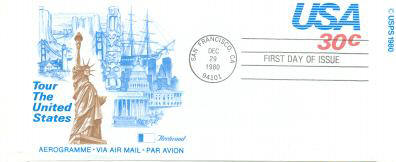
Aerogram
 Aerogram - A
sheet of paper (usually blue) previously obtained from the post office. The
paper is lightweight and has an airmail stamp design printed on it.
It is used to write a one-page, personal letter to someone overseas.
Aerograms are normally unfolded when purchased. After writing
a letter directly on the unprinted side of the aerogram, the writer
folds the aerogram and seals it. He/she then adds an address
under the preprinted postage. (The United States Postal Service no
longer sells aerograms.)
Aerogram - A
sheet of paper (usually blue) previously obtained from the post office. The
paper is lightweight and has an airmail stamp design printed on it.
It is used to write a one-page, personal letter to someone overseas.
Aerograms are normally unfolded when purchased. After writing
a letter directly on the unprinted side of the aerogram, the writer
folds the aerogram and seals it. He/she then adds an address
under the preprinted postage. (The United States Postal Service no
longer sells aerograms.)
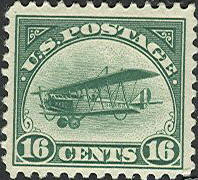
An airmail stamp
 Airmail - Mail
that is carried aboard an airliner as opposed to mail that is
carried on a ship or other surface vehicle. In olden days, airmail
was much faster and much more costly. All mail within the USA now
goes airmail (if it’s going far enough) for the price of a regular,
1st-class stamp. As of July 9, 1995, all international letters and
international post cards mailed from the USA started being sent
airmail automatically.
Airmail - Mail
that is carried aboard an airliner as opposed to mail that is
carried on a ship or other surface vehicle. In olden days, airmail
was much faster and much more costly. All mail within the USA now
goes airmail (if it’s going far enough) for the price of a regular,
1st-class stamp. As of July 9, 1995, all international letters and
international post cards mailed from the USA started being sent
airmail automatically.
 Air Post - See “air mail.”
Air Post - See “air mail.”
 Album - A binder containing
pages upon which to mount stamps. Most albums have preprinted pages
with pictures and/or descriptions of the stamps that are to go in
each space.
Album - A binder containing
pages upon which to mount stamps. Most albums have preprinted pages
with pictures and/or descriptions of the stamps that are to go in
each space.
 Album set - Sometimes a
collection is too large to fit in one album. A world-wide collection
may have so many pages that it takes from 2 to 30 or more books
(albums) to hold it. Generally all of the books in one collection
are called an album set. Each book or album is called a volume.
Album set - Sometimes a
collection is too large to fit in one album. A world-wide collection
may have so many pages that it takes from 2 to 30 or more books
(albums) to hold it. Generally all of the books in one collection
are called an album set. Each book or album is called a volume.
 Album supplement - Usually once
a year you may buy additional pages for an album set from the
album’s publisher. This gives you pages with places for all the
“new” stamps issued in the last year. Of course, because of the time
it takes to design the pages and print them, it may take a year or
two (or more) after a stamp is issued before a place for that stamp
ends up on an album page. Some companies treat album supplements as
a subscription-type thing and either send them automatically or send
a card advising that they are now available.
Album supplement - Usually once
a year you may buy additional pages for an album set from the
album’s publisher. This gives you pages with places for all the
“new” stamps issued in the last year. Of course, because of the time
it takes to design the pages and print them, it may take a year or
two (or more) after a stamp is issued before a place for that stamp
ends up on an album page. Some companies treat album supplements as
a subscription-type thing and either send them automatically or send
a card advising that they are now available.
 American Philatelic Society (APS)
- Founded in 1886 and headquartered in Bellefonte, Pennsylvania,
the APS is one of the foremost philatelic organizations in the
world. Membership is open to stamp collectors and stamp dealers
worldwide, and members agree to abide by strict codes of ethics in
all their stamp dealings. The APS publishes a monthly magazine,
conducts education and training classes, maintains an extensive
library, runs a sales division for members wishing to buy and sell
stamps, provides a stamp expertization service, etc.
American Philatelic Society (APS)
- Founded in 1886 and headquartered in Bellefonte, Pennsylvania,
the APS is one of the foremost philatelic organizations in the
world. Membership is open to stamp collectors and stamp dealers
worldwide, and members agree to abide by strict codes of ethics in
all their stamp dealings. The APS publishes a monthly magazine,
conducts education and training classes, maintains an extensive
library, runs a sales division for members wishing to buy and sell
stamps, provides a stamp expertization service, etc.
 American Stamp Dealers Association (ASDA)
- A professional organization representing stamp dealers. Like the
APS, the ASDA also maintains strict codes of ethics for its members.
American Stamp Dealers Association (ASDA)
- A professional organization representing stamp dealers. Like the
APS, the ASDA also maintains strict codes of ethics for its members.
 Appraisal - An estimate by a
stamp professional to determine the value of a stamp collection.
Appraisal - An estimate by a
stamp professional to determine the value of a stamp collection.
 Average (AVG) - See
chapter 3.
Average (AVG) - See
chapter 3.
 Back of book (BOB) - Scott
catalogs, and therefore many albums, are organized in this order:
regular postage stamps, semi-postal stamps, airmail stamps, special
delivery stamps, revenue stamps, etc. The regular stamps are in the
front of the book or album. Everything else is behind this in the
back of the book.
Back of book (BOB) - Scott
catalogs, and therefore many albums, are organized in this order:
regular postage stamps, semi-postal stamps, airmail stamps, special
delivery stamps, revenue stamps, etc. The regular stamps are in the
front of the book or album. Everything else is behind this in the
back of the book.
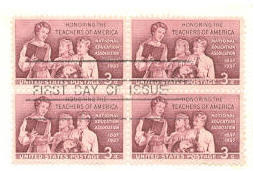
Block of 4
 Block of 4 -
Four stamps together in a square. Also see “plate block.” A plate
block has a plate number in the margins, whereas a block of 4 does
not.
Block of 4 -
Four stamps together in a square. Also see “plate block.” A plate
block has a plate number in the margins, whereas a block of 4 does
not.
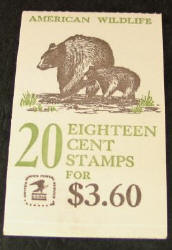
 Booklet -
Booklets consist of a front and back cover with small panes of
stamps sandwiched in the middle. Many people purchase booklet stamps
(also referred to as a book of stamps) at the post office because
the booklet protects the stamps when placed in a pocket or purse.
Booklet -
Booklets consist of a front and back cover with small panes of
stamps sandwiched in the middle. Many people purchase booklet stamps
(also referred to as a book of stamps) at the post office because
the booklet protects the stamps when placed in a pocket or purse.
 Booklet pane - One of the small
panes of stamps inside a booklet or one which has been removed from
a booklet. Simply tearing out the stamps does not make a booklet
pane. The booklet is glued together on one end. To the side of the
stamps is a small piece of paper, called a tab, where the glue is
applied. To be defined as a booklet pane, the tab must still be
attached to the stamps.
Booklet pane - One of the small
panes of stamps inside a booklet or one which has been removed from
a booklet. Simply tearing out the stamps does not make a booklet
pane. The booklet is glued together on one end. To the side of the
stamps is a small piece of paper, called a tab, where the glue is
applied. To be defined as a booklet pane, the tab must still be
attached to the stamps.
 Bourse - A gathering of stamp
dealers where people can buy, sell or trade stamps. May be held in
association with a stamp show or under sponsorship of a dealer
organization.
Bourse - A gathering of stamp
dealers where people can buy, sell or trade stamps. May be held in
association with a stamp show or under sponsorship of a dealer
organization.
 Broken set - An incomplete set.
A particular stamp is printed as a set of four, for example. If you
only have one, two or three of the stamps, you have a broken set.
Broken set - An incomplete set.
A particular stamp is printed as a set of four, for example. If you
only have one, two or three of the stamps, you have a broken set.
 Brown spots - Stamps which have
been subjected to too much humidity may develop small brown spots or
other discoloration. The spots are caused by mold or mildew.
Brown spots - Stamps which have
been subjected to too much humidity may develop small brown spots or
other discoloration. The spots are caused by mold or mildew.
 Bureau of Engraving and Printing (BEP)
- The official printer of all USA currency and, until recently, all
postage stamps.
Bureau of Engraving and Printing (BEP)
- The official printer of all USA currency and, until recently, all
postage stamps.

Cachet on a first day cover
 Cachet - On
first day covers, an artist may paint a drawing on the left side of
the envelope. The drawing is related to the subject of the stamp.
The cachet may be original artwork, or it may be a reproduction. The
purpose of the cachet is simply to make the cover more interesting.
Cachet - On
first day covers, an artist may paint a drawing on the left side of
the envelope. The drawing is related to the subject of the stamp.
The cachet may be original artwork, or it may be a reproduction. The
purpose of the cachet is simply to make the cover more interesting.
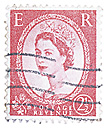
A canceled stamp
 Canceled - Postmarked.
The post office applies a cancellation mark to prevent
reusing the stamp. As an added benefit, if the stamp is still
attached to an envelope, you may (usually) read the
date the letter was mailed.
Canceled - Postmarked.
The post office applies a cancellation mark to prevent
reusing the stamp. As an added benefit, if the stamp is still
attached to an envelope, you may (usually) read the
date the letter was mailed.
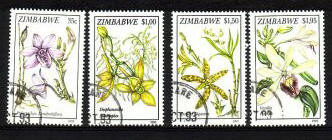
Zimbabwe CTOs
 Canceled to order (CTO) - Some
governments print stamps and then immediately cancel them. The CTOs
are then sold in huge quantities to collectors. The price to a
collector is less than buying a mint stamp at face value; however,
the process still produces a lot of revenue for the country. CTOs
may be spotted in a set of stamps when the cancellation is in
exactly the same spot on each stamp. Normally the cancellation is
simply part of a circle in one corner of the stamp. Another tip is
to look for a canceled stamp that still has all its gum on the back.
CTOs are not highly regarded by many collectors and usually command
lower prices than a mint stamp or a used stamp that was actually
used to mail a letter.
Canceled to order (CTO) - Some
governments print stamps and then immediately cancel them. The CTOs
are then sold in huge quantities to collectors. The price to a
collector is less than buying a mint stamp at face value; however,
the process still produces a lot of revenue for the country. CTOs
may be spotted in a set of stamps when the cancellation is in
exactly the same spot on each stamp. Normally the cancellation is
simply part of a circle in one corner of the stamp. Another tip is
to look for a canceled stamp that still has all its gum on the back.
CTOs are not highly regarded by many collectors and usually command
lower prices than a mint stamp or a used stamp that was actually
used to mail a letter.
 Centering - See
chapter 3.
Centering - See
chapter 3.

Cinderella
 Cinderella -
Something that looks like a stamp but is not a stamp. Many
organizations print stamp-like items for advertising purposes, to
raise funds or to make some sort of political statement. The
Cinderella usually has gum on the back and can be pasted on an
envelope. Cinderellas are not listed in Scott’s, and are often
ignored by many collectors.
Cinderella -
Something that looks like a stamp but is not a stamp. Many
organizations print stamp-like items for advertising purposes, to
raise funds or to make some sort of political statement. The
Cinderella usually has gum on the back and can be pasted on an
envelope. Cinderellas are not listed in Scott’s, and are often
ignored by many collectors.
 Circuit book - The American
Philatelic Society (APS) allows members wishing to sell stamps to
place stamps in small 16-page books. The books are sent to the APS
and circulated to other members who wish to buy stamps. Individual
stamps are removed by the members and payment is sent back to APS.
APS subtracts a commission, then sends a check for the balance to
the original owner of the stamps.
Circuit book - The American
Philatelic Society (APS) allows members wishing to sell stamps to
place stamps in small 16-page books. The books are sent to the APS
and circulated to other members who wish to buy stamps. Individual
stamps are removed by the members and payment is sent back to APS.
APS subtracts a commission, then sends a check for the balance to
the original owner of the stamps.

Stamps from a Coil
Notice there are no perforations on the top and bottom.
 Coil - A roll of
stamps, normally 100 stamps long. Coils may be as long as 10,000
stamps. Coil stamps are
normally collected in lengths of 2, 3 or 5 stamps.
Coil - A roll of
stamps, normally 100 stamps long. Coils may be as long as 10,000
stamps. Coil stamps are
normally collected in lengths of 2, 3 or 5 stamps.
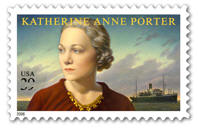
Commemorative Stamp
 Commemorative -
Stamps which honor individuals, special anniversaries, special
events, etc.
Commemorative -
Stamps which honor individuals, special anniversaries, special
events, etc.
 Commemorative panels - A special
letter-size page issued by the USPS as a collectible. It has the
stamp subject mounted in a plastic sleeve. There is a descriptive
story about the stamp printed on the page.
Commemorative panels - A special
letter-size page issued by the USPS as a collectible. It has the
stamp subject mounted in a plastic sleeve. There is a descriptive
story about the stamp printed on the page.
 Condition - See
chapter 3.
Condition - See
chapter 3.
 Confederate States of America (CSA)
- During the Civil War, the CSA (a.k.a., The South) issued its own
postage stamps.
Confederate States of America (CSA)
- During the Civil War, the CSA (a.k.a., The South) issued its own
postage stamps.
 Consignment - Placing stamps
with a dealer who will pay you for the stamps once he/she finds
someone who wishes to buy them. The dealer normally collects a
commission (around 15% to 25%) for handling the stamps.
Consignment - Placing stamps
with a dealer who will pay you for the stamps once he/she finds
someone who wishes to buy them. The dealer normally collects a
commission (around 15% to 25%) for handling the stamps.
 Counterfeit - Fake, worthless.
Here again is a place for the word “usually.” Some collectors
actually collect fakes, and some fakes may actually be valuable.
This is especially true if the fake has been used on a cover. If you
happen to have inherited a specialized collection of fakes, you will
want to consult a professional.
Counterfeit - Fake, worthless.
Here again is a place for the word “usually.” Some collectors
actually collect fakes, and some fakes may actually be valuable.
This is especially true if the fake has been used on a cover. If you
happen to have inherited a specialized collection of fakes, you will
want to consult a professional.
 Country Collection - A
collection of stamps of just one country. A collection of U.S.A.
stamps is a country collection as are collections of stamps of Great
Britain, Canada, France, Germany, etc. This is a rather loose term.
A country collection might also be a little wider than this, such
as: British Empire, British Middle East, Spain & Colonies, German
States, etc. These collections may also be called “area
collections.” Country and area collections sometimes are wider in
scope; in addition to postage stamps, the collector may have saved
booklet panes, covers, special cancellations, Cinderellas, etc.
Country Collection - A
collection of stamps of just one country. A collection of U.S.A.
stamps is a country collection as are collections of stamps of Great
Britain, Canada, France, Germany, etc. This is a rather loose term.
A country collection might also be a little wider than this, such
as: British Empire, British Middle East, Spain & Colonies, German
States, etc. These collections may also be called “area
collections.” Country and area collections sometimes are wider in
scope; in addition to postage stamps, the collector may have saved
booklet panes, covers, special cancellations, Cinderellas, etc.
 Cover - An envelope with a stamp
attached that has been sent through the mail system. Many collectors
collect covers because of their markings, cancellations or for the
story the cover conveys.
Cover - An envelope with a stamp
attached that has been sent through the mail system. Many collectors
collect covers because of their markings, cancellations or for the
story the cover conveys.
 Cut-squares - Stamps, surrounded
by a margin of paper, cut from stamped envelopes.
Cut-squares - Stamps, surrounded
by a margin of paper, cut from stamped envelopes.
 Damaged gum (DG) - The glue on
the back of the stamp has been damaged by moisture, a stamp hinge,
handling, etc. Disturbed gum is synonymous.
Damaged gum (DG) - The glue on
the back of the stamp has been damaged by moisture, a stamp hinge,
handling, etc. Disturbed gum is synonymous.
 Date/Country Collection - Some
world-wide albums (notably the Scott International Album) are
organized by date and then by country. The first two volumes of a
Scott International (numbered volumes 1A and 1B, but commonly just
called volume 1) deal with the stamps from the 1800s up to 1940; the
next two (volumes 2A and 2B) cover 1940 to 1949; the next two are
from 1949 to 1955. Within each date period, Scott puts the countries
in sort of alphabetical order. If you have a date/country collection
and you wish to see all the stamps of France, for example, you may
need to look in 30 different books. Some collectors try to convert
Date/Country album sets to A-Z album sets with mixed results.
Because of the printing on both sides of the pages, it is not always
possible to keep all the countries in proper alphabetical order,
then in proper date order.
Date/Country Collection - Some
world-wide albums (notably the Scott International Album) are
organized by date and then by country. The first two volumes of a
Scott International (numbered volumes 1A and 1B, but commonly just
called volume 1) deal with the stamps from the 1800s up to 1940; the
next two (volumes 2A and 2B) cover 1940 to 1949; the next two are
from 1949 to 1955. Within each date period, Scott puts the countries
in sort of alphabetical order. If you have a date/country collection
and you wish to see all the stamps of France, for example, you may
need to look in 30 different books. Some collectors try to convert
Date/Country album sets to A-Z album sets with mixed results.
Because of the printing on both sides of the pages, it is not always
possible to keep all the countries in proper alphabetical order,
then in proper date order.
 Dealer - A person or company who
buys and sells stamps and other philatelic material.
Dealer - A person or company who
buys and sells stamps and other philatelic material.

Definitive Stamp
 Definitive -
Stamps which the post office sells over long periods of time. These
are the standard-use stamps which are issued in sheet form, booklet
form or coil form. Most definitives issued in the USA are generic
and contain pictures of historical figures, eagles, flags, and so
forth. See “commemorative.”
Definitive -
Stamps which the post office sells over long periods of time. These
are the standard-use stamps which are issued in sheet form, booklet
form or coil form. Most definitives issued in the USA are generic
and contain pictures of historical figures, eagles, flags, and so
forth. See “commemorative.”
 Disturbed gum - See “damaged
gum.”
Disturbed gum - See “damaged
gum.”
 Domestic Mail Manual (DMM) - A
2,000-page book issued by the USPS which explains all the rules for
mailing within the USA. You may read the DMM online on the
USPS's web site:
http://pe.usps.com/
Domestic Mail Manual (DMM) - A
2,000-page book issued by the USPS which explains all the rules for
mailing within the USA. You may read the DMM online on the
USPS's web site:
http://pe.usps.com/
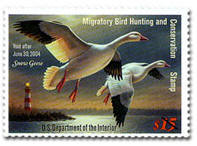
Duck Stamp
 Duck Stamps -
These are hunting-permit stamps issued by the United States
Department of the Interior or state equivalent. Duck stamps are
not valid for postage. They are attached to the back of a
hunting license to validate the license, and then they are signed by
the hunter.
Duck Stamps -
These are hunting-permit stamps issued by the United States
Department of the Interior or state equivalent. Duck stamps are
not valid for postage. They are attached to the back of a
hunting license to validate the license, and then they are signed by
the hunter.
 Dunes - A slang term for certain
countries in the Middle East that issue large quantities of stamps
to generate revenue from collectors. These countries now form the
United Arab Emirates and are sometimes referred to as Trucial
States. While colorful and attractive, the stamp designs often
do not relate to the country of issue. The stamps are not sought
after by most serious collectors. See “wallpaper.”
Dunes - A slang term for certain
countries in the Middle East that issue large quantities of stamps
to generate revenue from collectors. These countries now form the
United Arab Emirates and are sometimes referred to as Trucial
States. While colorful and attractive, the stamp designs often
do not relate to the country of issue. The stamps are not sought
after by most serious collectors. See “wallpaper.”
 Error - A stamp with something
major wrong in the way it was manufactured. A multi-color stamp may
have one color omitted, for example. Major errors receive separate
catalog listings and may have significant additional value. See
“Errors, Freaks and Oddities.”
Error - A stamp with something
major wrong in the way it was manufactured. A multi-color stamp may
have one color omitted, for example. Major errors receive separate
catalog listings and may have significant additional value. See
“Errors, Freaks and Oddities.”
 Errors, Freaks and Oddities (EFOs)
- See “Error,” “Freak” and “Oddity” entries. The distinction between
what is an error, freak or oddity is very blurry. Most collectors
lump them together as EFOs. EFOs tend to bring higher prices. A
recent 29-cent stamp, for example, has a catalog value of 50 cents.
The same stamp was also printed with the “29c” missing on a few
stamps. This “error” stamp has a catalog value of $125.
Errors, Freaks and Oddities (EFOs)
- See “Error,” “Freak” and “Oddity” entries. The distinction between
what is an error, freak or oddity is very blurry. Most collectors
lump them together as EFOs. EFOs tend to bring higher prices. A
recent 29-cent stamp, for example, has a catalog value of 50 cents.
The same stamp was also printed with the “29c” missing on a few
stamps. This “error” stamp has a catalog value of $125.
 Essay - It is beyond the scope
of this book to define four terms completely: proof, essay, trials
and specimens. These are all terms associated with preparing a stamp
for printing. These may be high-value items. If you have inherited a
specialized collection of these items, you will probably want to
contact a professional.
Essay - It is beyond the scope
of this book to define four terms completely: proof, essay, trials
and specimens. These are all terms associated with preparing a stamp
for printing. These may be high-value items. If you have inherited a
specialized collection of these items, you will probably want to
contact a professional.
 Expanding set - See “set.”
Expanding set - See “set.”
 Expertization - For a fee, the
American Philatelic Society and other organizations will render an
expert opinion that a stamp is genuine. They may also offer opinions
on whether the cancellation is genuine, the stamp’s condition, etc.
Stamp expertization is covered in
chapter 23.
Expertization - For a fee, the
American Philatelic Society and other organizations will render an
expert opinion that a stamp is genuine. They may also offer opinions
on whether the cancellation is genuine, the stamp’s condition, etc.
Stamp expertization is covered in
chapter 23.
 Extra Fine (XF) - See
chapter 3.
Extra Fine (XF) - See
chapter 3.
 Face value - The value the stamp
sells for when originally sold by the post office. A 39-cent stamp
has a face value of 39 cents.
Face value - The value the stamp
sells for when originally sold by the post office. A 39-cent stamp
has a face value of 39 cents.
 Facsimile - See “Fake.”
Facsimile - See “Fake.”
 Fake - Stamps, like currency,
are sometimes forged by individuals who want to make a profit by
selling junk to unsuspecting collectors or by cheating the postal
service out of revenue. Fakes cause collectors untold trouble
because the stamps may be so well done. Fakes can also occur in
other ways. Several companies have printed sheets illustrating the
most valuable stamps in the world. Some collectors cut the “stamp”
from the sheet and place it in their albums. Remember, a stamp
collector loves to fill blank spaces!
Fake - Stamps, like currency,
are sometimes forged by individuals who want to make a profit by
selling junk to unsuspecting collectors or by cheating the postal
service out of revenue. Fakes cause collectors untold trouble
because the stamps may be so well done. Fakes can also occur in
other ways. Several companies have printed sheets illustrating the
most valuable stamps in the world. Some collectors cut the “stamp”
from the sheet and place it in their albums. Remember, a stamp
collector loves to fill blank spaces!
 Fine (F) - See
chapter 3.
Fine (F) - See
chapter 3.
 Fine-Very Fine (F-VF) - See
chapter 3.
Fine-Very Fine (F-VF) - See
chapter 3.
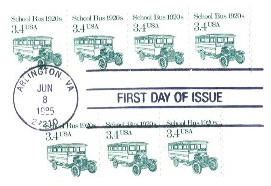
Part of a first day cover
(enlarged to show the cancellation).
A true first day cover would include the entire envelope.
 First day cover (FDC)
- Stamps on an envelope, often with a cachet, may receive a special
cancellation on the first day the stamp is officially placed into
usage by the postal service. United States FDCs since the mid-1930s
normally have the words “First Day of Issue” in the cancellation.
The cover must be intact to be a FDC; removing the stamp from the
envelope (obviously) ruins the whole thing.
First day cover (FDC)
- Stamps on an envelope, often with a cachet, may receive a special
cancellation on the first day the stamp is officially placed into
usage by the postal service. United States FDCs since the mid-1930s
normally have the words “First Day of Issue” in the cancellation.
The cover must be intact to be a FDC; removing the stamp from the
envelope (obviously) ruins the whole thing.
 First day of issue - See “first
day cover.”
First day of issue - See “first
day cover.”
 First flight cover - An envelope
with a stamp on it that has flown on a new airline route on the very
first flight. The envelope is normally rubber stamped or printed
with the airline, date, flight number, etc.
First flight cover - An envelope
with a stamp on it that has flown on a new airline route on the very
first flight. The envelope is normally rubber stamped or printed
with the airline, date, flight number, etc.
 Flown Zepp - See “Zepps.”
Flown Zepp - See “Zepps.”
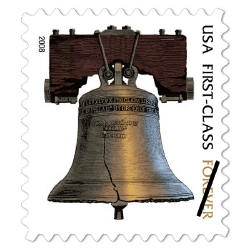
 Forever Stamps
The USPS issues stamps with "Forever" printed on them. Each
stamp can be used to mail a one-ounce First-Class letter at any
time, now or in the future. Other counties issue stamps which
serve a similar purpose.
Forever Stamps
The USPS issues stamps with "Forever" printed on them. Each
stamp can be used to mail a one-ounce First-Class letter at any
time, now or in the future. Other counties issue stamps which
serve a similar purpose.
 Forgery - See Fake.
Forgery - See Fake.
 Freak - An irregularity caused
by a paper shift or a perforation shift during the printing process.
An example is the perforations of the stamp going down the center of
the design. Freaks generally are worth much more than the regular
stamp. See “Errors, Freaks and Oddities.”
Freak - An irregularity caused
by a paper shift or a perforation shift during the printing process.
An example is the perforations of the stamp going down the center of
the design. Freaks generally are worth much more than the regular
stamp. See “Errors, Freaks and Oddities.”
 Glassine - A wax-paper-like
envelope used to hold and protect stamps.
Glassine - A wax-paper-like
envelope used to hold and protect stamps.
 Good (G) - See
chapter 3.
Good (G) - See
chapter 3.
 Gum - The glue on the back of
the stamp. The USPS first began issuing self-adhesive stamps
in 1974. Before that, all stamps were "lick-and-stick"; one
licked the gum on the back of the stamp to moisten it, and then the
stamp was affixed to an envelope. Today, the vast majority (if
not all) of the United States postage stamps are self-adhesive.
Gum - The glue on the back of
the stamp. The USPS first began issuing self-adhesive stamps
in 1974. Before that, all stamps were "lick-and-stick"; one
licked the gum on the back of the stamp to moisten it, and then the
stamp was affixed to an envelope. Today, the vast majority (if
not all) of the United States postage stamps are self-adhesive.
 Hammer price - At an auction,
the auctioneer normally says something like “Sold for $1 million
dollars!” and then bangs his/her gavel (hammer) on the podium.
That’s a hammer price. In purchasing stamps, both the buyer and the
seller may have to pay a percentage of the hammer price to the
auction house. On the $1 million sale example, assuming an auction
house percentage of 10%, the buyer would have to come up with $1.1
million and the seller would get a check for $900,000. The auction
house would keep $200,000.
Hammer price - At an auction,
the auctioneer normally says something like “Sold for $1 million
dollars!” and then bangs his/her gavel (hammer) on the podium.
That’s a hammer price. In purchasing stamps, both the buyer and the
seller may have to pay a percentage of the hammer price to the
auction house. On the $1 million sale example, assuming an auction
house percentage of 10%, the buyer would have to come up with $1.1
million and the seller would get a check for $900,000. The auction
house would keep $200,000.
 Heavily canceled - See
chapter 3.
Heavily canceled - See
chapter 3.
 Heavily hinged (HH) - A rather
subjective term implying the hinge is really stuck to the stamp. The
hinge is probably very old and is not at all attractive.
Heavily hinged (HH) - A rather
subjective term implying the hinge is really stuck to the stamp. The
hinge is probably very old and is not at all attractive.

Packet of stamp hinges
 Hinge - A small piece of gummed
paper used to attach a stamp to an album page. The hinge is folded
in the middle. You lick the hinge on one side and attach it to the
back of the stamp. Next you lick the hinge on the other side and
press the stamp onto the album. From the perspective of inheriting a
collection, hinges are very, very bad things! A hinge greatly
detracts from the value of a mint stamp. It usually does not detract
at all from the value of a used stamp; however, removing the hinge
may damage the stamp, and this will detract from the value. See the
box “Hinges, etc.” at the end of this chapter.
Hinge - A small piece of gummed
paper used to attach a stamp to an album page. The hinge is folded
in the middle. You lick the hinge on one side and attach it to the
back of the stamp. Next you lick the hinge on the other side and
press the stamp onto the album. From the perspective of inheriting a
collection, hinges are very, very bad things! A hinge greatly
detracts from the value of a mint stamp. It usually does not detract
at all from the value of a used stamp; however, removing the hinge
may damage the stamp, and this will detract from the value. See the
box “Hinges, etc.” at the end of this chapter.
 Hingeless album - A more
expensive kind of album, only available in the last 30 years or so.
It looks like a regular stamp album except each space where a stamp
goes has a built-in plastic stamp mount. The collector merely slides
the stamp into the mount. There is no need for stamp hinges or
having to put stamps in regular stamp mounts.
Hingeless album - A more
expensive kind of album, only available in the last 30 years or so.
It looks like a regular stamp album except each space where a stamp
goes has a built-in plastic stamp mount. The collector merely slides
the stamp into the mount. There is no need for stamp hinges or
having to put stamps in regular stamp mounts.
 Hunting-permit stamps - See
“Duck stamps.”
Hunting-permit stamps - See
“Duck stamps.”
 Imitation - See “Fake.”
Imitation - See “Fake.”
 Imperforate (Imperf.) - Usually
applicable to early stamps from the 1800s. Some stamps were printed
in sheets without perforation holes. To separate the stamps, the
postal clerk or customer had to cut the stamps apart using scissors
or a ruler.
Imperforate (Imperf.) - Usually
applicable to early stamps from the 1800s. Some stamps were printed
in sheets without perforation holes. To separate the stamps, the
postal clerk or customer had to cut the stamps apart using scissors
or a ruler.
 International Mail Manual (IMM)
- This 1,000-page book from the USPS explains how to send mail from
the USA to international destinations. You may read the IMM
online on the USPS's web site:
http://pe.usps.com/
International Mail Manual (IMM)
- This 1,000-page book from the USPS explains how to send mail from
the USA to international destinations. You may read the IMM
online on the USPS's web site:
http://pe.usps.com/

Inverted Jenny
 Inverted Jenny -
A 24-cent airmail stamp issued in 1918 with a picture of an
upside-down airplane printed in the middle by accident. Scott
catalog number C3a. (Although I have not touched on this yet, the
prefix “C” on the front of a Scott number indicates an airmail
stamp. The lower-case “a” on the end indicates it is a variation, in
this case the first listed variation, of the stamp numbered C3.) If
you do have an inverted Jenny, you might well be able to pay off a
house mortgage with it! Important: in the 2000s, the USPS
issued a commemorative Two Dollar stamp with an inverted Jenny.
That's worth $2.00. Supposedly, the USPS also printed a small
percentage of Two Dollar stamps with the Jenny right-side-up.
I've never seen one of those, but if you find one, it will be worth
checking out its value.
Inverted Jenny -
A 24-cent airmail stamp issued in 1918 with a picture of an
upside-down airplane printed in the middle by accident. Scott
catalog number C3a. (Although I have not touched on this yet, the
prefix “C” on the front of a Scott number indicates an airmail
stamp. The lower-case “a” on the end indicates it is a variation, in
this case the first listed variation, of the stamp numbered C3.) If
you do have an inverted Jenny, you might well be able to pay off a
house mortgage with it! Important: in the 2000s, the USPS
issued a commemorative Two Dollar stamp with an inverted Jenny.
That's worth $2.00. Supposedly, the USPS also printed a small
percentage of Two Dollar stamps with the Jenny right-side-up.
I've never seen one of those, but if you find one, it will be worth
checking out its value.
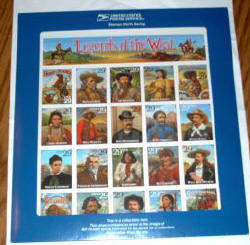
Recalled Legends of the West Sheet
in sleeve
 Legends of the West (LOTW)
- In 1994, the USPS issued a sheet of twenty stamps
containing pictures of twenty Old-West persons or scenes. One of the
pictures was of a man named Bill Pickett. Just before the stamps
were released, the USPS found out that the picture of Bill Pickett
was not of Bill at all, but was a picture of Bill’s brother. The
USPS recalled all of the stamps that had been distributed to post
offices but not sold. It planned to destroy them. However, about 200
sheets had been sold prematurely, and thus immediately became worth
thousands of dollars each. In order to prevent this, the USPS
decided to auction off 150,000 of the recalled sheets. Each of
these sheets was packaged in a special display sleeve. The recalled
Legends of the West Sheets (RLOW) now have a value ranging from $150
to $250. The USPS subsequently redrew Pickett’s picture and other
details in the sheet and issued the corrected version.
Legends of the West (LOTW)
- In 1994, the USPS issued a sheet of twenty stamps
containing pictures of twenty Old-West persons or scenes. One of the
pictures was of a man named Bill Pickett. Just before the stamps
were released, the USPS found out that the picture of Bill Pickett
was not of Bill at all, but was a picture of Bill’s brother. The
USPS recalled all of the stamps that had been distributed to post
offices but not sold. It planned to destroy them. However, about 200
sheets had been sold prematurely, and thus immediately became worth
thousands of dollars each. In order to prevent this, the USPS
decided to auction off 150,000 of the recalled sheets. Each of
these sheets was packaged in a special display sleeve. The recalled
Legends of the West Sheets (RLOW) now have a value ranging from $150
to $250. The USPS subsequently redrew Pickett’s picture and other
details in the sheet and issued the corrected version.
 Lightly canceled - See
chapter 3
Lightly canceled - See
chapter 3
 Lightly hinged (LH) - A stamp
that has had a hinge applied to it. Usually, the hinge has been
removed leaving very little trace that it was ever there, i.e., it
did not do much damage to the stamp’s gum.
Lightly hinged (LH) - A stamp
that has had a hinge applied to it. Usually, the hinge has been
removed leaving very little trace that it was ever there, i.e., it
did not do much damage to the stamp’s gum.
 Linn’s - Linn’s Stamp News.
A popular weekly newspaper about stamps, published in Sidney, Ohio.
Linn’s - Linn’s Stamp News.
A popular weekly newspaper about stamps, published in Sidney, Ohio.
 Lot - A group of philatelic
material bought or sold for one price. The term is usually used in
connection with auctions.
Lot - A group of philatelic
material bought or sold for one price. The term is usually used in
connection with auctions.
 Miniature sheet - A stamp or
several stamps printed with wide margins on all sides. The margins
contain drawings and/or words. Miniature sheets normally commemorate
some kind of a special event or anniversary. The distinction between
a miniature sheet and a souvenir sheet is somewhat blurred.
Miniature sheet - A stamp or
several stamps printed with wide margins on all sides. The margins
contain drawings and/or words. Miniature sheets normally commemorate
some kind of a special event or anniversary. The distinction between
a miniature sheet and a souvenir sheet is somewhat blurred.
 Minkus - A publisher of stamp
catalogs and albums, and a competitor of Scott’s.
Minkus - A publisher of stamp
catalogs and albums, and a competitor of Scott’s.
 Mint - A stamp that has never
been used. Stamps purchased new at the post office are mint stamps.
Mint - A stamp that has never
been used. Stamps purchased new at the post office are mint stamps.
 Mint, hinged (MH) - A stamp that
is mint and has had a hinge applied to it at one time or another. It
does not matter if the hinge is still affixed to the stamp or not.
The hinge will leave traces in the gum on the back of the stamp.
This is further discussed in
chapter 3.
Mint, hinged (MH) - A stamp that
is mint and has had a hinge applied to it at one time or another. It
does not matter if the hinge is still affixed to the stamp or not.
The hinge will leave traces in the gum on the back of the stamp.
This is further discussed in
chapter 3.
 Mint, never hinged (MNH) - A
stamp that is mint and has never had a hinge applied to it. Stamps
purchased new at the post office are MNH. MNH are normally the
easiest to sell.
Mint, never hinged (MNH) - A
stamp that is mint and has never had a hinge applied to it. Stamps
purchased new at the post office are MNH. MNH are normally the
easiest to sell.
 Missing perforations - A stamp
where some of the perforation teeth have been torn off as a result
of rough handling. Missing perfs reduce the value of a stamp.
Missing perforations - A stamp
where some of the perforation teeth have been torn off as a result
of rough handling. Missing perfs reduce the value of a stamp.
 Mount - See “stamp mount.”
Mount - See “stamp mount.”
 No Gum (NG) - The stamp has no
gum upon it. Some stamps were issued without gum. More often, this
indicates the stamp was used to mail a letter, but it missed the
canceling machine.
No Gum (NG) - The stamp has no
gum upon it. Some stamps were issued without gum. More often, this
indicates the stamp was used to mail a letter, but it missed the
canceling machine.
Subsequently, someone has soaked the stamp off of the envelope. If a
stamp were issued without gum, this fact is noted in the stamp’s
listing in the Scott catalogs.
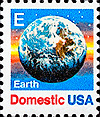
Non-denominated "E" stamp.
Issued in 1978, the "E" stamp had a postage value of 25 cents.
 Non-denominated Stamps:
The United States Postal Service has issued dozens of stamps
without an actual numeric value printed on them. A lot of
these stamps were printed because 1) the postal service had
requested a rate hike, and 2) they needed to get billions of stamps
printed and ready to sell, but 3) they were not 100% sure their
request would be approved for the full amount. Rather
than print billions of stamps with the wrong value, the postal
service used stamps with letters on them (A, B, C, D, E, F, G, etc)
and other means to identify a stamp's value. This chart from the
United States Postal Service will show you how much each stamp is
worth:
http://pe.usps.com/text/qsg300/Q604a.htm. Another chart is
available from Linn's Stamp News:
http://www.linns.com/howto/refresher/nondenominated_20011231/refreshercourse.asp?uID=
Non-denominated Stamps:
The United States Postal Service has issued dozens of stamps
without an actual numeric value printed on them. A lot of
these stamps were printed because 1) the postal service had
requested a rate hike, and 2) they needed to get billions of stamps
printed and ready to sell, but 3) they were not 100% sure their
request would be approved for the full amount. Rather
than print billions of stamps with the wrong value, the postal
service used stamps with letters on them (A, B, C, D, E, F, G, etc)
and other means to identify a stamp's value. This chart from the
United States Postal Service will show you how much each stamp is
worth:
http://pe.usps.com/text/qsg300/Q604a.htm. Another chart is
available from Linn's Stamp News:
http://www.linns.com/howto/refresher/nondenominated_20011231/refreshercourse.asp?uID=
 Numismatic - Relating to coins.
Numismatic - Relating to coins.
 Oddity - Some unusual philatelic
item. An example may be a stamp in a slightly different color than
it is supposed to be. An oddity may or may not be worth any more
than the “correct” stamp. See “Errors, Freaks and Oddities.”
Oddity - Some unusual philatelic
item. An example may be a stamp in a slightly different color than
it is supposed to be. An oddity may or may not be worth any more
than the “correct” stamp. See “Errors, Freaks and Oddities.”
 Off paper - Stamps that have
been soaked off of envelopes.
Off paper - Stamps that have
been soaked off of envelopes.
 Offices in ... - Some countries
maintained post offices in foreign countries. You will see listings
such as “United States Offices in China” or “Great Britain Offices
in Morocco”. Most collectors collect “offices” as part of the main
country. The Scott catalog usually lists the offices just after the
end of the main country listings.
Offices in ... - Some countries
maintained post offices in foreign countries. You will see listings
such as “United States Offices in China” or “Great Britain Offices
in Morocco”. Most collectors collect “offices” as part of the main
country. The Scott catalog usually lists the offices just after the
end of the main country listings.
 Official Stamp -
A stamp that may only be used by federal government agencies to mail
letters and packages. Individuals may never use these for
postage. These are the stamps that have the famous "Penalty
for Private Use $300" on them.
Official Stamp -
A stamp that may only be used by federal government agencies to mail
letters and packages. Individuals may never use these for
postage. These are the stamps that have the famous "Penalty
for Private Use $300" on them.
 On paper - A stamp that is still
attached to part of the envelope. Normally there is about 1/4 to 3/4
inch of paper left on each side of the stamp. Collectors frequently
cut stamps from envelopes and intend to soak the envelope part off
later. A stamp that is still attached to the entire envelope is
called a cover.
On paper - A stamp that is still
attached to part of the envelope. Normally there is about 1/4 to 3/4
inch of paper left on each side of the stamp. Collectors frequently
cut stamps from envelopes and intend to soak the envelope part off
later. A stamp that is still attached to the entire envelope is
called a cover.
 Original gum (OG) - This term is
used in a variety of ways. Literally, it means a stamp has some or
all of its gum left. Many people use the term as a synonym of
hinged. The most desirable state for a mint stamp is Full Original
Gum which is understood to mean “without a hinge or other mark.”
Mint, never hinged (MNH) is the more common term for Full Original
Gum.
Original gum (OG) - This term is
used in a variety of ways. Literally, it means a stamp has some or
all of its gum left. Many people use the term as a synonym of
hinged. The most desirable state for a mint stamp is Full Original
Gum which is understood to mean “without a hinge or other mark.”
Mint, never hinged (MNH) is the more common term for Full Original
Gum.
 Overprint - Sometimes
governments take sheets of stamps and run them back through the
printing press to add additional information. This might be done for
a special occasion such as the visit of a dignitary, “Honoring the
Visit of Her Majesty. June 1958”. It is less expensive to overprint
an existing stamp than to make a brand new design. See “surcharge.”
Overprint - Sometimes
governments take sheets of stamps and run them back through the
printing press to add additional information. This might be done for
a special occasion such as the visit of a dignitary, “Honoring the
Visit of Her Majesty. June 1958”. It is less expensive to overprint
an existing stamp than to make a brand new design. See “surcharge.”
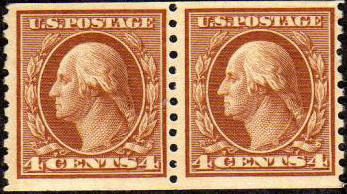
A pair of stamps
 Pair - Two of
the same stamp still connected together.
Pair - Two of
the same stamp still connected together.
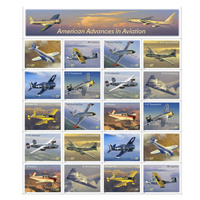
A pane of stamps
 Pane - A sheet
of stamps purchased at the post office.
Pane - A sheet
of stamps purchased at the post office.
 Perforation (perf) - The small
holes between the stamps used to separate individual stamps easily.
The bridges around the holes are called teeth.
Perforation (perf) - The small
holes between the stamps used to separate individual stamps easily.
The bridges around the holes are called teeth.
 Philatelic - Related to
philately.
Philatelic - Related to
philately.
 Philately - (fĭ lăt́ě lĭ) - The
collection and study of stamps, covers and other postal materials.
Philately - (fĭ lăt́ě lĭ) - The
collection and study of stamps, covers and other postal materials.

Plate Block
 Plate block -
Traditionally, a block of four stamps with the sheet margin still
attached. The printing plate number appears in the margin. In more
recent stamps, more than one plate number appears in the margin
indicating several printing plates have been used. These are usually
done in different colors. There is some confusion about just what
constitutes a plate block on these newer stamps. At different times
in U.S. stamp production, plate blocks have been four stamp to a
block, six stamps to a block, and even up to 20 stamps to a block
with two complete rows of stamps adjoining the margin with the plate
numbers. The listing in the Scott catalog will indicate how many
stamps constitute a plate block for a particular stamp.
Plate block -
Traditionally, a block of four stamps with the sheet margin still
attached. The printing plate number appears in the margin. In more
recent stamps, more than one plate number appears in the margin
indicating several printing plates have been used. These are usually
done in different colors. There is some confusion about just what
constitutes a plate block on these newer stamps. At different times
in U.S. stamp production, plate blocks have been four stamp to a
block, six stamps to a block, and even up to 20 stamps to a block
with two complete rows of stamps adjoining the margin with the plate
numbers. The listing in the Scott catalog will indicate how many
stamps constitute a plate block for a particular stamp.
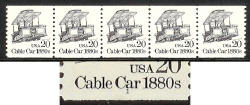
Plate Number Coil. This is a
PNC5.
(Note the tiny "1" under "Car" in the middle stamp.)
Click to enlarge.
 Plate number coils (PNC) - On
coils of stamps issued in the USA since 1981, a tiny number appears
in the center bottom of every so many stamps. This may be every
tenth stamp, or every thirty-second stamp or whatever. It varies
based on the equipment used to print the stamp. The number is used
to identify a company or plate that printed the stamps. Collectors
generally collect a strip of three or five stamps with the plate
number in the center. These are sometimes called PNC3s and PNC5s.
Some collectors only collect the individual stamp with the plate
number on it. These are called PNC singles.
Plate number coils (PNC) - On
coils of stamps issued in the USA since 1981, a tiny number appears
in the center bottom of every so many stamps. This may be every
tenth stamp, or every thirty-second stamp or whatever. It varies
based on the equipment used to print the stamp. The number is used
to identify a company or plate that printed the stamps. Collectors
generally collect a strip of three or five stamps with the plate
number in the center. These are sometimes called PNC3s and PNC5s.
Some collectors only collect the individual stamp with the plate
number on it. These are called PNC singles.
 PNC single - See “plate number
coils.”
PNC single - See “plate number
coils.”
 Post card - The item you send
the kids when you go to Hawaii, and they get left at home! You must
apply a stamp to mail it. See “postal card.”
Post card - The item you send
the kids when you go to Hawaii, and they get left at home! You must
apply a stamp to mail it. See “postal card.”
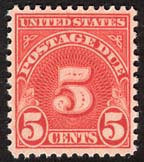
Postage due stamp
 Postage due -
Special stamps previously used by the post office when insufficient postage
was
applied to a letter mailed to you. The USPS no longer uses
postage due stamps.
Postage due -
Special stamps previously used by the post office when insufficient postage
was
applied to a letter mailed to you. The USPS no longer uses
postage due stamps.
 Postal Card - A card sold by the
USPS or the postal agency of another country with the stamp already
printed or embossed on it.
Postal Card - A card sold by the
USPS or the postal agency of another country with the stamp already
printed or embossed on it.
 Postal Stationery - Includes
stamped envelopes, postal cards and aerograms.
Postal Stationery - Includes
stamped envelopes, postal cards and aerograms.
 Poster stamp - A Cinderella.
Normally a larger-size stamp that was issued for advertising
purposes. These were more common before WWII.
Poster stamp - A Cinderella.
Normally a larger-size stamp that was issued for advertising
purposes. These were more common before WWII.
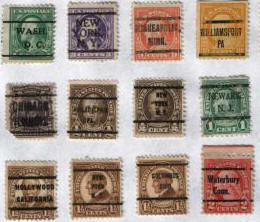
Precanceled stamps with city/state
names
 Precancels - The
post office has sometimes printed black lines, city/state names or
service inscriptions on sheets of stamps and then sold the stamps to
bulk mailers. The mailer applies the stamps to its letters and then
returns the letters to the post office. This saves the post office
time because it does not have to run the individual letters through
the canceling machine. See “Service Inscriptions.”
Precancels - The
post office has sometimes printed black lines, city/state names or
service inscriptions on sheets of stamps and then sold the stamps to
bulk mailers. The mailer applies the stamps to its letters and then
returns the letters to the post office. This saves the post office
time because it does not have to run the individual letters through
the canceling machine. See “Service Inscriptions.”
 Private treaty - Normally a
large dealer or auction house can act as an agent for you. They will
receive your material, advertise it, publicize it and hopefully find
a buyer. This kind of sale is normally done for expensive material
that is so specialized there would not be enough interested buyers
at an auction. This is similar in concept to a consignment sale,
although doesn’t “private treaty” sound a little more glamorous?
Private treaty - Normally a
large dealer or auction house can act as an agent for you. They will
receive your material, advertise it, publicize it and hopefully find
a buyer. This kind of sale is normally done for expensive material
that is so specialized there would not be enough interested buyers
at an auction. This is similar in concept to a consignment sale,
although doesn’t “private treaty” sound a little more glamorous?
 Proof - See “Essay.”
Proof - See “Essay.”
 Recalled Legends of the West (RLOTW)
- See “Legends of the West.”
Recalled Legends of the West (RLOTW)
- See “Legends of the West.”
 Registration stamps - Stamps
issued by some countries specifically for use on registered mail.
Registration stamps - Stamps
issued by some countries specifically for use on registered mail.
 Regular issue - A generic term
meaning “normal” stamps used to mail everyday letters. Regular
issues do not include airmail, semi-postal, postage due, special
delivery, revenue, duck stamps, etc. See also “Definitive” and
“Commemorative.”
Regular issue - A generic term
meaning “normal” stamps used to mail everyday letters. Regular
issues do not include airmail, semi-postal, postage due, special
delivery, revenue, duck stamps, etc. See also “Definitive” and
“Commemorative.”
 Regummed - A process of applying
new gum onto the back of a stamp where some or all of its original
gum is missing. This is normally done to hide flaws or improperly
increase the value of a stamp.
Regummed - A process of applying
new gum onto the back of a stamp where some or all of its original
gum is missing. This is normally done to hide flaws or improperly
increase the value of a stamp.
 Reprint - Occasionally,
governments and others get old printing plates and run off more
copies of an older stamp. In general, the reprints are worth much
less than the original; however, there are exceptions.
Reprint - Occasionally,
governments and others get old printing plates and run off more
copies of an older stamp. In general, the reprints are worth much
less than the original; however, there are exceptions.
 Reserve bid - When selling
stamps at an auction, the seller sometimes specifies that he/she
will not accept a bid for less than “x” dollars. This is the minimum
amount acceptable and is called a reserve bid.
Reserve bid - When selling
stamps at an auction, the seller sometimes specifies that he/she
will not accept a bid for less than “x” dollars. This is the minimum
amount acceptable and is called a reserve bid.
 Revenue stamps - Tax stamps
issued by a government which were affixed to various items to
indicate that tax has been paid, e.g., revenue stamps on liquor
bottles and deeds. These are considered back-of-the-book items.
Revenue stamps - Tax stamps
issued by a government which were affixed to various items to
indicate that tax has been paid, e.g., revenue stamps on liquor
bottles and deeds. These are considered back-of-the-book items.
 Scott Catalog (SC) - Scott
Publishing Company, Sidney, Ohio, publishes a set of catalogs called
Scott Standard Postage Stamp Catalogues. The catalogs list most
stamps of the USA and of the world and assign a number to each. The
catalogs also list the approximate retail price which a dealer might
charge for a particular stamp. This will be discussed in more detail
in
chapter 3 and
chapter 22. Probably 95% of all collectors and dealers in the
USA use Scott catalog numbers and prices.
Scott Catalog (SC) - Scott
Publishing Company, Sidney, Ohio, publishes a set of catalogs called
Scott Standard Postage Stamp Catalogues. The catalogs list most
stamps of the USA and of the world and assign a number to each. The
catalogs also list the approximate retail price which a dealer might
charge for a particular stamp. This will be discussed in more detail
in
chapter 3 and
chapter 22. Probably 95% of all collectors and dealers in the
USA use Scott catalog numbers and prices.

Scott USA 2446 on a first day
cover
 Scott Catalog Number - A unique
number assigned to each stamp of a particular country. For example,
Scott USA 2446 is the 25-cent “Gone With The Wind” stamp issued in
1990. Since each country’s stamp numbering starts with the number
one, it is necessary to state the country as well as the Scott
number to properly identify a stamp.
Scott Catalog Number - A unique
number assigned to each stamp of a particular country. For example,
Scott USA 2446 is the 25-cent “Gone With The Wind” stamp issued in
1990. Since each country’s stamp numbering starts with the number
one, it is necessary to state the country as well as the Scott
number to properly identify a stamp.
 Scott Catalog Value (SCV) - The
Scott catalog lists two approximate retail prices for each stamp in
the world. There is one price for mint stamps and another price for
used stamps. The prices approximate what a stamp dealer “usually”
charges his/her customers for a particular stamp if sold singly.
The Scott catalog value is not, repeat not, the price you are going
to get when you sell the stamps you inherited! More on this in
later chapters.
Scott Catalog Value (SCV) - The
Scott catalog lists two approximate retail prices for each stamp in
the world. There is one price for mint stamps and another price for
used stamps. The prices approximate what a stamp dealer “usually”
charges his/her customers for a particular stamp if sold singly.
The Scott catalog value is not, repeat not, the price you are going
to get when you sell the stamps you inherited! More on this in
later chapters.
 Self-addressed, stamped envelope (SASE)
-. A #10 SASE is a business-size
Self-addressed, stamped envelope (SASE)
-. A #10 SASE is a business-size
(4-1/8 x 9-1/2 inches), self-addressed, stamped envelope.
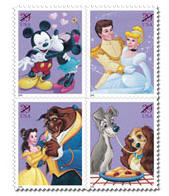
Se-tenant Stamps
 Se-tenant - Two
or more stamp designs attached in a block or a strip. The most
common configuration is a block of four stamps with a different
design on each. (Pronounced: Say-tenant.)
Se-tenant - Two
or more stamp designs attached in a block or a strip. The most
common configuration is a block of four stamps with a different
design on each. (Pronounced: Say-tenant.)
 Selvage - The margins around the
edges of a sheet or pane of stamps. Usually contains a plate number,
a copyright notice or some other message like “Mail Early in the
Day.”
Selvage - The margins around the
edges of a sheet or pane of stamps. Usually contains a plate number,
a copyright notice or some other message like “Mail Early in the
Day.”
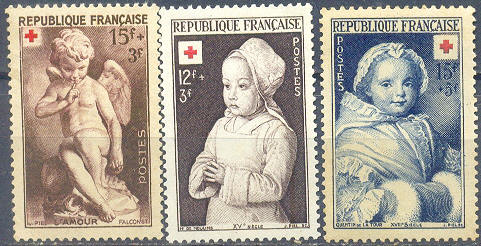
French semi-postal stamps.
Note the one in the middle is for 12 francs postage
plus 3 francs to the charity.
 Semi-postal -
Many countries sell postage stamps and collect money for a charity
at the same time. Some stamps will have a value like 10c + 2c. The
stamp sells for 12c; 10c is good for postage, and 2c is sent from
the post office to the charity. There are a few USA
semipostals marked with things like "Forever +" or "First-Class +".
Semi-postal -
Many countries sell postage stamps and collect money for a charity
at the same time. Some stamps will have a value like 10c + 2c. The
stamp sells for 12c; 10c is good for postage, and 2c is sent from
the post office to the charity. There are a few USA
semipostals marked with things like "Forever +" or "First-Class +".
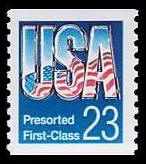
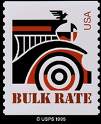
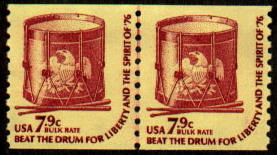
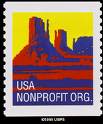
Service-inscribed stamps
 Service inscriptions
- Much of the “junk” mail that arrives at our homes used to have
service-inscribed stamps. There are markings such as “bulk rate,”
“non-profit organization,” “pre-sorted first class,” etc. which are
printed on the stamps. The post office sells these to mass mailers.
The stamps are applied, and the letters delivered to the post
office. The letters are normally in trays to facilitate
transportation and distribution. Frequently, the letters are sorted
by ZIP code. The post office normally does not run the letters
through the canceling machine, thus saving themselves time and
money. Some service-inscribed stamps show integer
numeric values (e.g., 23 cents), some show fractional values (e.g.,
7.9 cents), and some do not show any value at all. If the
value is not shown, this chart from the United States Postal Service
will show you how much each stamp is worth:
http://pe.usps.com/text/qsg300/Q604a.htm. Another chart is
available from Linn's Stamp News:
http://www.linns.com/howto/refresher/nondenominated_20011231/refreshercourse.asp?uID=
Service inscriptions
- Much of the “junk” mail that arrives at our homes used to have
service-inscribed stamps. There are markings such as “bulk rate,”
“non-profit organization,” “pre-sorted first class,” etc. which are
printed on the stamps. The post office sells these to mass mailers.
The stamps are applied, and the letters delivered to the post
office. The letters are normally in trays to facilitate
transportation and distribution. Frequently, the letters are sorted
by ZIP code. The post office normally does not run the letters
through the canceling machine, thus saving themselves time and
money. Some service-inscribed stamps show integer
numeric values (e.g., 23 cents), some show fractional values (e.g.,
7.9 cents), and some do not show any value at all. If the
value is not shown, this chart from the United States Postal Service
will show you how much each stamp is worth:
http://pe.usps.com/text/qsg300/Q604a.htm. Another chart is
available from Linn's Stamp News:
http://www.linns.com/howto/refresher/nondenominated_20011231/refreshercourse.asp?uID=
 Set - A group of definitive or
commemorative stamps which belong together. The most common is
probably a group of four or six stamps of the same theme issued at
the same time. However, a set may consist of as few as two stamps or
as many as dozens. An “expanding set” is one where new values are
added years after the originals were issued. It can also mean that
additional, similar stamps are planned to be added in the future.
Set - A group of definitive or
commemorative stamps which belong together. The most common is
probably a group of four or six stamps of the same theme issued at
the same time. However, a set may consist of as few as two stamps or
as many as dozens. An “expanding set” is one where new values are
added years after the originals were issued. It can also mean that
additional, similar stamps are planned to be added in the future.
 Single - One stamp by itself.
Single - One stamp by itself.
 Soaking - Stamp collectors
sometimes cut gummed stamps off of envelopes leaving about 1/4 to 3/4
inch of paper around the stamp. The stamps are then placed in or
soaked in a dish of water. After about 10 minutes, the glue
dissolves, and the stamps float free. They are then completely dried
on paper towels, pressed between the pages of a large book such as a
telephone directory for a few days, and then placed in the album.
Soaking the newer self-adhesive stamps frequently does not work
well.
Soaking - Stamp collectors
sometimes cut gummed stamps off of envelopes leaving about 1/4 to 3/4
inch of paper around the stamp. The stamps are then placed in or
soaked in a dish of water. After about 10 minutes, the glue
dissolves, and the stamps float free. They are then completely dried
on paper towels, pressed between the pages of a large book such as a
telephone directory for a few days, and then placed in the album.
Soaking the newer self-adhesive stamps frequently does not work
well.
 Souvenir page - A page with a
description of a stamp. Attached to the sheet is one of the stamps
that has a first-day-of-issue cancellation. The USPS sells these
pages on a subscription basis.
Souvenir page - A page with a
description of a stamp. Attached to the sheet is one of the stamps
that has a first-day-of-issue cancellation. The USPS sells these
pages on a subscription basis.
 Souvenir sheet - A small sheet
of stamps which contains pictures or words in a large margin, and
which commemorates something.
Souvenir sheet - A small sheet
of stamps which contains pictures or words in a large margin, and
which commemorates something.
 Specialty Collection - A
collector may collect any number of specialized items: covers,
cancellations, errors, deeds with revenue stamps on them,
precancels, essays, etc. The possibilities are endless. If you have
inherited a specialty collection, more than likely you will need to
solicit professional help to determine its value.
Specialty Collection - A
collector may collect any number of specialized items: covers,
cancellations, errors, deeds with revenue stamps on them,
precancels, essays, etc. The possibilities are endless. If you have
inherited a specialty collection, more than likely you will need to
solicit professional help to determine its value.
 Specimen - See “Essay.”
Specimen - See “Essay.”
 Stamped envelope - The USPS and
postal agencies of other countries sell envelopes with a stamp
already printed or embossed upon it.
Stamped envelope - The USPS and
postal agencies of other countries sell envelopes with a stamp
already printed or embossed upon it.
 StampFolio - Similar in concept
to a commemorative panel and issued by the USPS. It usually contains
one stamp or a block of stamps on a colorful card.
StampFolio - Similar in concept
to a commemorative panel and issued by the USPS. It usually contains
one stamp or a block of stamps on a colorful card.
 Stampless covers - Postage
stamps were not invented until the mid-1800s. Before that,
postmasters would write or rubber stamp “Paid” (or other similar
words and/or postage amounts) on the envelope. This practice
continued for a time after the invention of postage stamps, but
eventually governments made the use of stamps mandatory.. Stampless
covers may have also been used during periods when postage stamps
were difficult to get, e.g., during wars. Stampless covers can be
very high-value items.
Stampless covers - Postage
stamps were not invented until the mid-1800s. Before that,
postmasters would write or rubber stamp “Paid” (or other similar
words and/or postage amounts) on the envelope. This practice
continued for a time after the invention of postage stamps, but
eventually governments made the use of stamps mandatory.. Stampless
covers may have also been used during periods when postage stamps
were difficult to get, e.g., during wars. Stampless covers can be
very high-value items.
 Stamp mount - A small plastic
sleeve with glue on the back. A stamp is inserted in the sleeve to
protect the stamp. The sleeve is then attached to the stamp album.
Stamp mounts have all but replaced stamp hinges. Stamp mounts do not
disturb the gum on the back of the stamp thereby increasing (or at
least preserving) the value of the stamp. See the box “Hinges, etc.”
at the end of this chapter.
Stamp mount - A small plastic
sleeve with glue on the back. A stamp is inserted in the sleeve to
protect the stamp. The sleeve is then attached to the stamp album.
Stamp mounts have all but replaced stamp hinges. Stamp mounts do not
disturb the gum on the back of the stamp thereby increasing (or at
least preserving) the value of the stamp. See the box “Hinges, etc.”
at the end of this chapter.
 Stamp show - A gathering of
dealers and collectors whose purpose is to buy, sell and trade
stamps. Frequently, there are displays of interesting philatelic
items, meetings and seminars on topics of interest.
Stamp show - A gathering of
dealers and collectors whose purpose is to buy, sell and trade
stamps. Frequently, there are displays of interesting philatelic
items, meetings and seminars on topics of interest.
 Stanley Gibbons - An English
publisher of stamp albums and catalogs, and a competitor of Scott’s.
Stanley Gibbons - An English
publisher of stamp albums and catalogs, and a competitor of Scott’s.
 Stock book - A book that has
small slots in it. Stamps are placed loosely inside the slots. The
books normally are made of the same kind of paper as manila folders.
Stock books can have pages with plastic pockets in them to hold
stamps.
Stock book - A book that has
small slots in it. Stamps are placed loosely inside the slots. The
books normally are made of the same kind of paper as manila folders.
Stock books can have pages with plastic pockets in them to hold
stamps.
 Straight edge (SE) - An edge of
a stamp that does not have perforations. A coil stamp has two edges
that have perforations and two that are straight. A stamp from a
booklet normally has two straight edges and two perforated edges.
The position in the booklet determines which edges are straight and
which edges are perforated. USA sheet stamps up until the 1930s
often have one or two straight edges. See “trimmed” also.
Straight edge (SE) - An edge of
a stamp that does not have perforations. A coil stamp has two edges
that have perforations and two that are straight. A stamp from a
booklet normally has two straight edges and two perforated edges.
The position in the booklet determines which edges are straight and
which edges are perforated. USA sheet stamps up until the 1930s
often have one or two straight edges. See “trimmed” also.
 Superb - See
chapter 3.
Superb - See
chapter 3.
 Supplement - See “album
supplement.”
Supplement - See “album
supplement.”
 Surcharge - Sometimes
governments take sheets of stamps and run them through the printing
presses again. They cross out an old denomination and add a new one.
Surcharges are very common in countries that have high inflation
rates and must constantly increase the price of stamps. See
“Overprint.”
Surcharge - Sometimes
governments take sheets of stamps and run them through the printing
presses again. They cross out an old denomination and add a new one.
Surcharges are very common in countries that have high inflation
rates and must constantly increase the price of stamps. See
“Overprint.”
 Tab - Some countries, notably
Israel, print designs related to the subject of the stamp on the
selvage as well as the stamp. A stamp with part of the selvage
attached is known as a tabbed stamp. Israeli tabbed stamps have a
higher catalog value than the ones without tabs. A different type of
tab is part of a booklet pane. See “booklet pane.”
Tab - Some countries, notably
Israel, print designs related to the subject of the stamp on the
selvage as well as the stamp. A stamp with part of the selvage
attached is known as a tabbed stamp. Israeli tabbed stamps have a
higher catalog value than the ones without tabs. A different type of
tab is part of a booklet pane. See “booklet pane.”
 Tagged - The USPS and postal
agencies of some other countries use a special phosphorus coating
(called a “taggant”) on some stamps. The taggant is added to the ink
used to print the stamp, or it is added directly to the paper on
which the stamp is printed. It can be seen under ultra-violet light.
The post office uses a machine, called a facer/canceller, to detect
the tagging. The tagging tells the machine that a stamp is attached,
and where the stamp is on the envelope.
Tagged - The USPS and postal
agencies of some other countries use a special phosphorus coating
(called a “taggant”) on some stamps. The taggant is added to the ink
used to print the stamp, or it is added directly to the paper on
which the stamp is printed. It can be seen under ultra-violet light.
The post office uses a machine, called a facer/canceller, to detect
the tagging. The tagging tells the machine that a stamp is attached,
and where the stamp is on the envelope.
 Tear - A rip in the stamp
because of mishandling. A tear greatly reduces the value of a stamp.
Tear - A rip in the stamp
because of mishandling. A tear greatly reduces the value of a stamp.
 Tetch-beche - A pair of stamps
where one is printed upside down relative to the other one. This is
common in triangular stamps issued by some countries. The triangle,
after all, is simply a rectangle that has been bisected diagonally.
Tetch-beche - A pair of stamps
where one is printed upside down relative to the other one. This is
common in triangular stamps issued by some countries. The triangle,
after all, is simply a rectangle that has been bisected diagonally.
 Thin - Sometimes a hinge is
removed from a stamp. Removal of the hinge not only removes some of
the gum, but it also may pull out a portion of the paper of the
stamp as well. This leaves a small, thin spot where the hinge used
to be, greatly reducing the value of the stamp.
Thin - Sometimes a hinge is
removed from a stamp. Removal of the hinge not only removes some of
the gum, but it also may pull out a portion of the paper of the
stamp as well. This leaves a small, thin spot where the hinge used
to be, greatly reducing the value of the stamp.

Pitcairn Island stamps that are
tied to cover
 Tied to cover -
A cancellation mark that touches the stamp as well as the envelope.
If checking dates in the postmark, this more or less proves that
that stamp was really mailed on that envelope on the date shown.
Tied to cover -
A cancellation mark that touches the stamp as well as the envelope.
If checking dates in the postmark, this more or less proves that
that stamp was really mailed on that envelope on the date shown.
 Tongs - Specially designed,
flat-end tweezers used to pick up and move stamps. The use of tongs
prevents damage to the stamps by oil on the fingers.
Tongs - Specially designed,
flat-end tweezers used to pick up and move stamps. The use of tongs
prevents damage to the stamps by oil on the fingers.
 Topical Collection - A stamp
collection, usually worldwide, arranged by topic. For example, a
collector may collect only stamps with pictures of ships on them; or
he/she may collect only stamps of birds, animals, flowers,
butterflies, John F. Kennedy, Star Wars, Harry Potter, etc. There
are hundreds of subjects. A collector may pick one subject or many.
Topical Collection - A stamp
collection, usually worldwide, arranged by topic. For example, a
collector may collect only stamps with pictures of ships on them; or
he/she may collect only stamps of birds, animals, flowers,
butterflies, John F. Kennedy, Star Wars, Harry Potter, etc. There
are hundreds of subjects. A collector may pick one subject or many.
 Trial - See “Essay.”
Trial - See “Essay.”
 Trimmed - A stamp has been
trimmed if someone cuts off the perforations to make a straight
edge. This may make the stamp look like a more valuable variety.
Sometimes the same stamp is issued in sheet form and coil form.
Trimming two edges on a sheet stamp makes it look like a coil stamp.
Trimming was not always done to defraud collectors. In days past, it
was not uncommon for a collector to trim a stamp because the space
in the album wasn’t large enough to hold the stamp!
Trimmed - A stamp has been
trimmed if someone cuts off the perforations to make a straight
edge. This may make the stamp look like a more valuable variety.
Sometimes the same stamp is issued in sheet form and coil form.
Trimming two edges on a sheet stamp makes it look like a coil stamp.
Trimming was not always done to defraud collectors. In days past, it
was not uncommon for a collector to trim a stamp because the space
in the album wasn’t large enough to hold the stamp!
 Trucial States - See “Dunes.”
Trucial States - See “Dunes.”
 Unexploded - A booklet of stamps
where the booklet panes have not been removed, i.e., a complete
booklet.
Unexploded - A booklet of stamps
where the booklet panes have not been removed, i.e., a complete
booklet.
 Upside-down Jenny - See Inverted
Jenny.
Upside-down Jenny - See Inverted
Jenny.
 Used (U) - A stamp that was
applied to a letter and mailed. The stamp has probably been thru a
canceling machine and has wavy lines or a postmark on it. See also
“canceled to order.”
Used (U) - A stamp that was
applied to a letter and mailed. The stamp has probably been thru a
canceling machine and has wavy lines or a postmark on it. See also
“canceled to order.”
 Very fine (VF) - See
chapter 3.
Very fine (VF) - See
chapter 3.
 Very good (VG) - See
chapter 3.
Very good (VG) - See
chapter 3.
 Volume - See “Album set.”
Volume - See “Album set.”
 Wallpaper - Some countries issue
many stamps which they sell to obtain hard currency. The stamps have
so little value that many people say they should be used the way one
would traditionally use wallpaper.
Wallpaper - Some countries issue
many stamps which they sell to obtain hard currency. The stamps have
so little value that many people say they should be used the way one
would traditionally use wallpaper.
 Want list - A list maintained by
a stamp collector of the stamps he/she needs for his/her collection.
Normally this is a list of countries and Scott numbers.
Want list - A list maintained by
a stamp collector of the stamps he/she needs for his/her collection.
Normally this is a list of countries and Scott numbers.
 Watermark - In many older
stamps, the paper was specially marked while it was being made. This
was done by pressing a pattern of wires into the paper before it
dried. Watermarks are usually hard to see with the naked eye.
Special fluids are needed to make the watermark visible. However,
this process can ruin the stamp. In general, one should let the
experts check for watermarks.
Watermark - In many older
stamps, the paper was specially marked while it was being made. This
was done by pressing a pattern of wires into the paper before it
dried. Watermarks are usually hard to see with the naked eye.
Special fluids are needed to make the watermark visible. However,
this process can ruin the stamp. In general, one should let the
experts check for watermarks.
 World-wide collection - A
collection containing all or almost all of the countries in the
world. Collectors may have more stamps from countries they like. It
is also possible that some of the countries have no stamps at all.
Sometimes, USA stamps are included in a world-wide collection;
sometimes they are moved to their own album by themselves. If they
are included in the worldwide collection, the album pages for USA
stamps are sometimes found in normal alphabetical order (e.g., under
the U’s) or sometimes at the front of the album before the A’s.
World-wide collection - A
collection containing all or almost all of the countries in the
world. Collectors may have more stamps from countries they like. It
is also possible that some of the countries have no stamps at all.
Sometimes, USA stamps are included in a world-wide collection;
sometimes they are moved to their own album by themselves. If they
are included in the worldwide collection, the album pages for USA
stamps are sometimes found in normal alphabetical order (e.g., under
the U’s) or sometimes at the front of the album before the A’s.


Two Zeppelin Stamps
 Zepps - Three
USA stamps that are coveted by collectors. The stamps are airmail
stamps issued in 1930 and have “Graf Zeppelin” printed at the top.
Each shows a picture of a zeppelin or blimp. Scott number C13 has a
face value of 65 cents; C14, $1.30; C15, $2.60. A mint set of one
each of these stamps will sell to a collector for over $1,000,
although condition of these stamps can greatly affect the price. A
“flown Zepp” is also a prized collectors’ item. This is an envelope
with a Zepp stamp attached (i.e., a cover) that actually flew on a
Zeppelin. If you have one of these, be sure not to soak the stamp
off!
Zepps - Three
USA stamps that are coveted by collectors. The stamps are airmail
stamps issued in 1930 and have “Graf Zeppelin” printed at the top.
Each shows a picture of a zeppelin or blimp. Scott number C13 has a
face value of 65 cents; C14, $1.30; C15, $2.60. A mint set of one
each of these stamps will sell to a collector for over $1,000,
although condition of these stamps can greatly affect the price. A
“flown Zepp” is also a prized collectors’ item. This is an envelope
with a Zepp stamp attached (i.e., a cover) that actually flew on a
Zeppelin. If you have one of these, be sure not to soak the stamp
off!
2.2: Stamp-related
Abbreviations
APS - American Philatelic Society.
ASDA - American Stamp Dealers Association.
AVG - Average.
BEP - Bureau of Engraving and Printing.
BOB - Back of book.
CSA - Confederate States of America.
CTO - Canceled to order.
CV - Catalog value.
DG - Damaged gum.
DG - Disturbed gum.
DMM - Domestic Mail Manual.
EFOs - Errors, freaks and oddities.
F - Fine.
F-VF - Fine, very-fine.
FDC - First day cover.
FMV - Fair market value.
G - Good.
H - Hinged.
HH - Heavily hinged.
IMM - International Mail Manual.
Imperf - Imperforate.
LH - Lightly hinged.
LOTW - Legends of the West.
M - Mint.
MH - Mint, hinged.
MNH - Mint, never hinged.
NG - No gum..
NH - Never hinged.
OG - Original gum.
Perf - Perforation.
PNC - Plate-number coil.
RLOTW - Recalled Legends of the West.
SASE - Self-addressed, stamped envelope.
SC - Scott catalog.
SCV - Scott catalog value.
SE - Straight edge.
SSAE - Stamped, self-addressed envelope. (SASE is more common.)
U - Used.
UN - Unused.
UN - United Nations.
USPS - United States Postal Service.
VF - Very fine.
VG - Very good.
WW - Worldwide.
WW - World War.
XF - Extra fine.






















